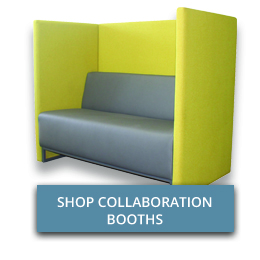We're long past umm-ing and ahh-ing about whether open offices are a good idea. Whether they are or aren't, they're here to stay. While they clearly encourage collaboration, there are some side effects to an un-checked—or un-planned—open office space:
1. Either the office is so silent, any noise is an interruption; or
2. There is an almost unstoppable stream of distracting noises.
This might seem like a mild inconvenience, but did you know that this level of interruption can cost billions in lost work productivity? The World Health Organisation estimates that excessive noise levels cost European organisations over 30bn Euros [NZ $55.14] annually.
Think about it this way: Every time your thought process is interrupted at work, it takes an average of 23 minutes to get back on track. In the process of writing this introduction, I've already been interrupted 3 times. That's an hour of productive work that has just magically disappeared.
So, how can you help your team get the kind of work environment that suits their work needs while still maintaining the collaborative aspect of an open office?

1. Introduce—and encourage—a messaging system
One of the biggest sources of interruption is your co-workers. And I get it; it's tricky. Sometimes, someone just quickly needs to ask a question that's too minor to warrant an email or a meeting. But a "quick question" for one person is half an hour of lost concentration for another. (And that's not including those people who are easily side-tracked into wider discussions.)
One way to mitigate this is to introduce a messaging system such as Slack. This allows your team to have more control over when they respond to queries from their co-workers. They can even choose to set themselves as busy or turn off notifications for a certain time period.
Look for messaging systems that have been built with collaboration in mind. Anything that helps you store files, make groups, video/phone calls and even search conversation history will help your team collaborate without needing to leave their desk.
2. Encourage visual cues
Social cues (like headphones) aren't always acknowledged. This is because everyone functions differently. For one person, headphones mean, "I'm working, leave me alone." But for their neighbour—who prefers to work from home when they need to concentrate—the headphones might as well not exist.
The important thing to do is to make sure everyone is on the same page. There are several ways to approach this. One is to have designated quiet areas physically sign-posted. Labels that quite literally say "Quiet Zone" will work as a visual reminder for your team.
Another option is to create a visual reminder that people can display on their desk. This could be anything from a small flag, a red light or a soft toy. The important thing is to communicate to the whole team that displaying this cue means, "I don't want to be interrupted."
This cue needs to be respected across the board. If you're a manager and you constantly break the cue to interrupt your team, you'll undermine the whole structure.
3. Office too quiet? Introduce white noise
It sounds counter-intuitive, but an office that's too quiet can actually be counter-productive. An environment that's so quiet you could actually hear a pin drop means that any noise – a spoon in a teacup, a sneeze, a distant toilet flush – breaks our concentration.
It turns out we concentrate best with a low-level hum in the background. So if your team aren't chatty, but you notice that most of them are wearing headphones anyway, it's probably because they need some kind of music or background noise to concentrate.
Introducing low-level noise could be as simple as opening some windows. Or, if that's not an option, think about installing a sound system and filter through some white noise or music designed to help you focus. Studies have found that sounds of nature increase our focus, too.
4. Check your floors
Polished concrete? Hardwood? Many modern offices are sporting this trendy industrial look. And it does look fantastic. But what does it sound like?
Hard materials like concrete and wood don't absorb sound. In fact, they reflect it. So not only are shoes making a sound on the hard floor, every noise in the office is reflected back off it.
Hopefully, your floors have come with sub-floor insulation and padding to help absorb noise. But if you're still struggling, consider fitting out the common areas with rugs. Make sure you use a non-slip rug underlay; this will do most of the sound dampening, plus stop your rugs from becoming a health hazard.
Also, consider chair mats and floor protector felt pads to soften the sound of chairs rolling or scraping on the floor.

5. Get clever with your furniture
Rearranging an office can be a hard task, but creating specific areas for different styles of work could make a world of difference to your office.
Collaborative Areas
By creating areas for people to gather informally, you'll encourage your team to take their discussions away from people who are trying to concentrate.
Sound-proof booths, such as this privacy booth or this 2 seater booth can be great for a group to have a quick conversation without disturbing the rest of the office. This is good for those times when you want to have a quick chat that doesn't need a dedicated hour in a meeting room.
Quiet working areas
Single pods like this privacy booth are great for people who need to get away for a phone call or to concentrate on a presentation that's due in an hour. Place these individual work pods far away from the collaboration areas (and don't forget to reinforce those social cues with signs).
Also, consider add-ons such as noise-dampening wall panels or lighting fixtures to help keep your spaces quiet.


Tweaking your office to get the "right" level of noise can seem like an impossible task. You need to consider the physical space, as well as the culture and etiquette present in your office. The most important thing to remember is that what works for one particular person can change multiple times a day. It's common for someone to cycle through work styles such as highly collaborative projects through concentrated individual work. Establishing an environment where people can choose the space that works for them at any given time will go a long way to building your team's efficiency.